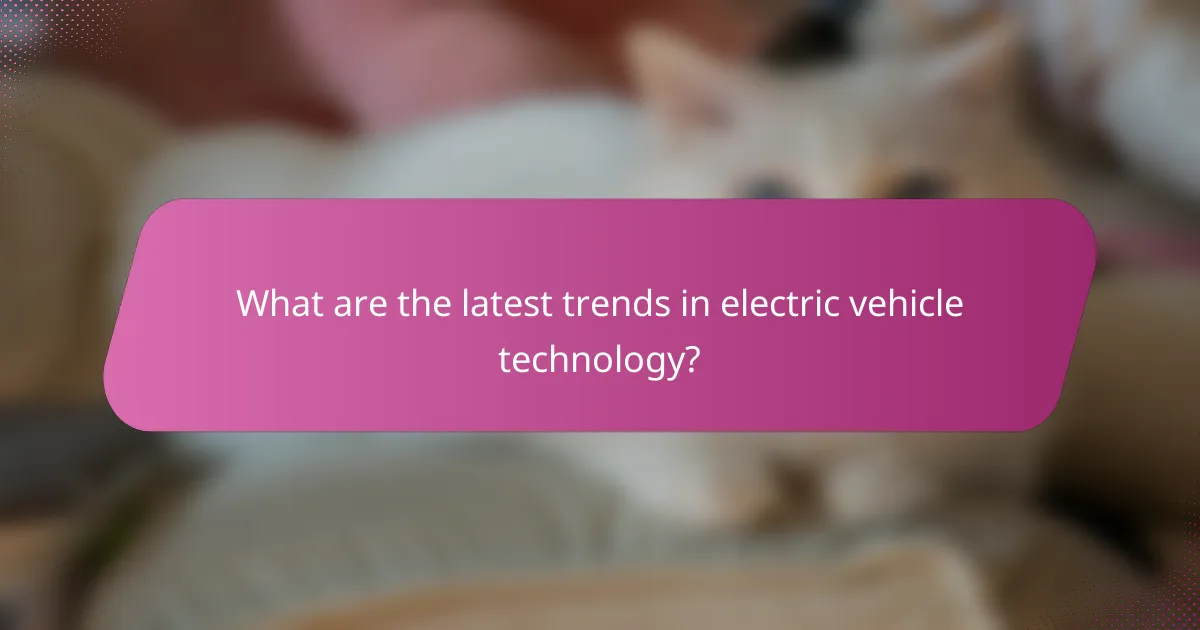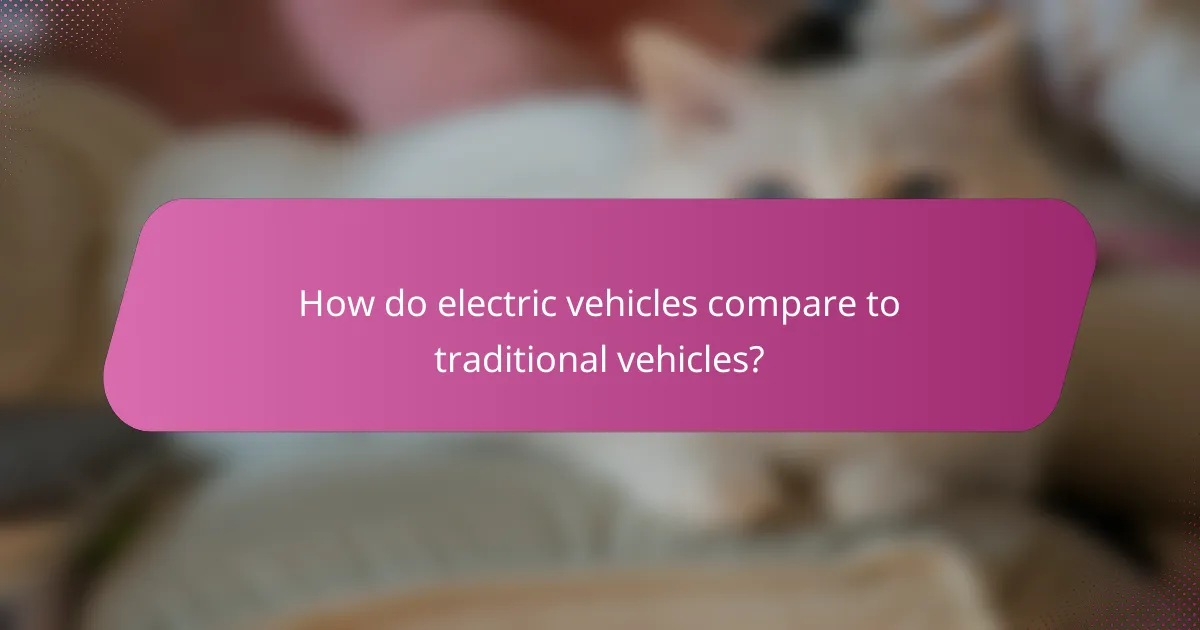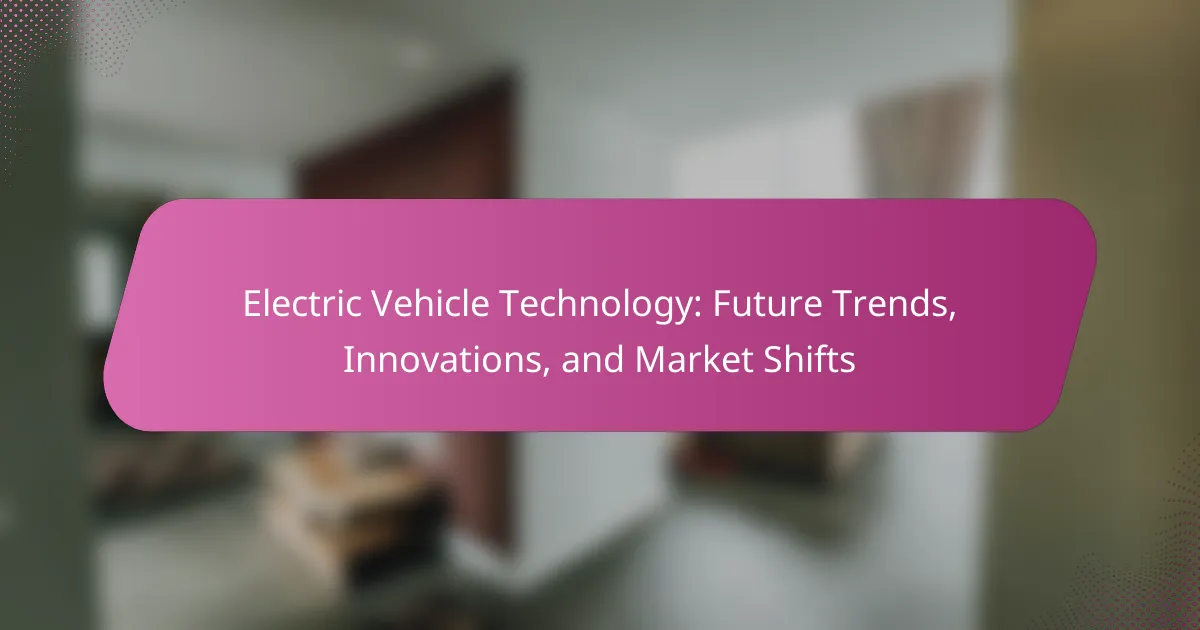The electric vehicle (EV) industry is undergoing a transformative shift, marked by significant advancements in technology that enhance performance, safety, and user experience. Innovations such as solid-state batteries, autonomous driving capabilities, and improved charging infrastructure are making EVs more accessible and appealing to consumers, paving the way for a sustainable future in transportation.

What are the latest trends in electric vehicle technology?
The latest trends in electric vehicle technology focus on enhancing performance, safety, and user experience. Key developments include advancements in battery technology, autonomous driving capabilities, vehicle-to-grid systems, improved charging infrastructure, and the use of lightweight materials.
Battery advancements
Battery technology is rapidly evolving, with a focus on increasing energy density and reducing charging times. Solid-state batteries are gaining attention for their potential to offer higher capacity and improved safety compared to traditional lithium-ion batteries. Current research suggests that these batteries could provide ranges of over 500 kilometers on a single charge.
Manufacturers are also exploring fast-charging solutions, aiming to reduce charging times to under 30 minutes for most vehicles. This shift could make electric vehicles more convenient for everyday use, comparable to refueling a gasoline car.
Autonomous driving features
Autonomous driving technology is becoming a standard feature in many new electric vehicles. These systems use a combination of sensors, cameras, and artificial intelligence to assist with driving tasks, enhancing safety and convenience. Levels of automation vary, with some vehicles offering advanced driver-assistance systems (ADAS) that can handle highway driving.
As regulations evolve, more manufacturers are expected to integrate higher levels of autonomy, potentially allowing fully self-driving capabilities in urban environments within the next decade.
Vehicle-to-grid technology
Vehicle-to-grid (V2G) technology enables electric vehicles to communicate with the power grid, allowing them to discharge electricity back to the grid during peak demand times. This capability can help stabilize the grid and provide financial incentives for EV owners. By participating in V2G programs, users may earn credits or payments for the energy their vehicles supply.
Implementing V2G requires compatible charging stations and regulatory support, which are gradually being developed in various regions, particularly in Europe and North America.
Charging infrastructure improvements
Charging infrastructure is expanding rapidly, with a focus on increasing the number of fast-charging stations. Many countries are investing in public charging networks to ensure that electric vehicle users have access to convenient charging options. Fast chargers can provide significant range in as little as 15-30 minutes, making long-distance travel more feasible.
Additionally, home charging solutions are becoming more accessible, with many new homes being built with dedicated EV charging points, further promoting electric vehicle adoption.
Lightweight materials usage
The use of lightweight materials, such as carbon fiber and aluminum, is becoming more prevalent in electric vehicle design. These materials help reduce overall vehicle weight, which can enhance efficiency and range. A lighter vehicle requires less energy to operate, directly impacting battery performance and driving range.
Manufacturers are increasingly incorporating these materials into their designs, balancing cost with performance benefits. The trend towards lightweight construction is expected to continue as technology advances and production methods improve.

How is electric vehicle technology evolving in North America?
Electric vehicle technology in North America is rapidly advancing, driven by innovations in battery efficiency, charging infrastructure, and vehicle design. These developments are shaping the market, making electric vehicles (EVs) more accessible and appealing to consumers.
Increased adoption rates
Adoption rates for electric vehicles in North America are on the rise, with many consumers opting for EVs due to environmental concerns and long-term cost savings. Recent trends indicate that sales of electric vehicles have increased significantly, with some estimates suggesting that EVs could make up a substantial portion of new vehicle sales within the next few years.
Factors contributing to this growth include improved vehicle range, lower operating costs, and a growing awareness of climate change. As more models become available, including affordable options, consumer interest in electric vehicles continues to expand.
Government incentives
Government incentives play a crucial role in the evolution of electric vehicle technology in North America. Federal and state programs often provide tax credits, rebates, and grants to encourage consumers to purchase EVs. For instance, the federal tax credit can offer up to several thousand dollars off the purchase price of an electric vehicle.
Additionally, many states have implemented their own incentives, which can include access to carpool lanes, reduced registration fees, and charging station installations. These incentives not only lower the initial cost of EVs but also promote the development of necessary infrastructure.
Partnerships with tech companies
Partnerships between automakers and technology companies are driving innovation in electric vehicle technology. Collaborations focus on enhancing battery technology, developing autonomous driving features, and improving software systems for better user experience. For example, partnerships with tech giants have led to advancements in vehicle connectivity and energy management systems.
These alliances enable automakers to leverage cutting-edge technology and expertise, accelerating the development of more efficient and feature-rich electric vehicles. As these partnerships grow, consumers can expect more sophisticated EVs that integrate seamlessly with smart technology and renewable energy sources.

What innovations are shaping the future of electric vehicles?
Innovations such as solid-state batteries, wireless charging systems, and advanced driver-assistance systems are significantly influencing the future of electric vehicles (EVs). These technologies promise to enhance performance, convenience, and safety, driving wider adoption of EVs in the coming years.
Solid-state batteries
Solid-state batteries represent a major advancement in energy storage for electric vehicles. Unlike traditional lithium-ion batteries that use liquid electrolytes, solid-state batteries utilize solid electrolytes, which can lead to higher energy density and improved safety.
These batteries can potentially offer longer ranges and faster charging times, making them an attractive option for manufacturers and consumers alike. However, challenges such as production costs and scalability remain, which could affect their widespread adoption in the near term.
Wireless charging systems
Wireless charging systems are transforming how electric vehicles are powered, allowing for convenient charging without the need for physical connections. This technology uses electromagnetic fields to transfer energy between a charging pad on the ground and a receiver on the vehicle.
While this innovation enhances user experience by eliminating plug-in hassles, it is essential to consider the efficiency of energy transfer and the need for compatible infrastructure. As cities and manufacturers invest in this technology, it may become a standard feature in urban environments.
Advanced driver-assistance systems
Advanced driver-assistance systems (ADAS) are crucial for enhancing the safety and functionality of electric vehicles. These systems utilize sensors, cameras, and artificial intelligence to assist drivers with features such as lane-keeping, adaptive cruise control, and automatic emergency braking.
As regulations around autonomous driving evolve, the integration of ADAS in electric vehicles is expected to increase. Consumers should look for vehicles equipped with robust ADAS features, as they can significantly improve safety and driving comfort.

What are the key players in the electric vehicle market?
The electric vehicle market features several key players that significantly influence trends and innovations. Major companies like Tesla, Rivian, and Ford are at the forefront, each contributing unique strategies and products to the evolving landscape of electric mobility.
Tesla’s market influence
Tesla remains a dominant force in the electric vehicle sector, known for its innovative technology and extensive charging infrastructure. The company’s focus on high-performance electric cars has set benchmarks for range and efficiency, making it a leader in consumer preference.
With models like the Model S, Model 3, Model X, and Model Y, Tesla has captured a substantial market share, often accounting for a significant percentage of electric vehicle sales in various regions. Their direct-to-consumer sales model and over-the-air software updates enhance customer experience and vehicle performance.
Rivian’s electric trucks
Rivian has carved out a niche in the electric vehicle market by focusing on electric trucks and SUVs, appealing to outdoor and adventure enthusiasts. Their R1T pickup and R1S SUV emphasize ruggedness and utility, with features tailored for off-road capabilities.
The company has garnered attention and investment, positioning itself as a competitor to traditional automakers. Rivian’s commitment to sustainability and innovative technology, such as a unique battery system, enhances its appeal in a growing market segment.
Ford’s electric vehicle strategy
Ford is actively transitioning to electric vehicles with a comprehensive strategy that includes the introduction of models like the Mustang Mach-E and the all-electric F-150 Lightning. This shift reflects Ford’s commitment to electrification and its aim to capture a share of the growing EV market.
The company plans to invest heavily in electric vehicle development, targeting a significant percentage of its lineup to be electric by the end of the decade. Ford’s established brand loyalty and extensive dealership network provide a strong foundation for its electric vehicle ambitions.

How do electric vehicles compare to traditional vehicles?
Electric vehicles (EVs) differ from traditional vehicles primarily in their power source and operational costs. While traditional vehicles rely on internal combustion engines fueled by gasoline or diesel, EVs use electric motors powered by batteries, leading to distinct advantages and challenges in ownership, environmental impact, and maintenance.
Cost of ownership
The cost of ownership for electric vehicles can be lower than that of traditional vehicles over time. Initial purchase prices for EVs may be higher, but savings on fuel and maintenance can offset these costs. For example, charging an EV typically costs less than fueling a gasoline vehicle, and many governments offer incentives or rebates that can reduce the upfront expense.
Additionally, EVs often qualify for lower registration fees and tax credits, which can further enhance their affordability. However, potential buyers should consider the availability of charging infrastructure and electricity rates in their area, as these can impact overall costs.
Environmental impact
Electric vehicles generally have a lower environmental impact compared to traditional vehicles, particularly in terms of greenhouse gas emissions. EVs produce zero tailpipe emissions, which contributes to improved air quality, especially in urban areas. However, the overall environmental benefit depends on how the electricity used to charge them is generated.
In regions where renewable energy sources are prevalent, the carbon footprint of EVs is significantly reduced. Conversely, if the electricity comes from fossil fuels, the environmental advantages may diminish. It’s essential to consider local energy sources when evaluating the sustainability of electric vehicles.
Maintenance requirements
Maintenance requirements for electric vehicles are typically lower than for traditional vehicles due to fewer moving parts in electric drivetrains. EVs do not require oil changes, and brake wear is often reduced thanks to regenerative braking systems. This can lead to lower long-term maintenance costs.
However, EV owners should be aware that battery maintenance and eventual replacement can be significant factors. Most manufacturers offer warranties on batteries that last several years, but understanding the lifespan and replacement costs is crucial for potential buyers. Regular checks on tire health and brake systems remain important for both EVs and traditional vehicles.



